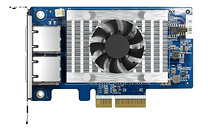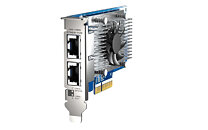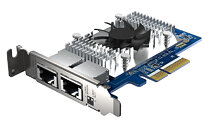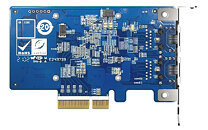Monday, May 31st 2021

QNAP Launches Dual 10 GbE Network Card for NAS & PC
QNAP Systems, Inc., today launched the new QXG-10G2T-X710 10 GbE network expansion card. Featuring an Intel Ethernet Controller X710, the QXG-10G2T-X710 is a PCIe Gen 3 card (compatible with PCIe Gen 2) that can be installed in a QNAP NAS or a Windows /Linux PC to add two 10 GbE ports. The QXG-10G2T-X710 supports is compatible with five speeds (10G / 5G / 2.5G / 1G / 100M) and can achieve up to 20 Gbps transfer speeds by using both ports with Port Trunking. Network efficiency is boosted with SR-IOV and iSCSI support, and I/O-intensive and latency-sensitive virtualization applications and data centers will greatly benefit. The QXG-10G2T-X710 is also a perfect match for QNAP's 10 GbE switches to build a budget-friendly high-speed network environment.
When installed in a Windows or Linux PC, users must install the QXG-10G2T-X710 driver. No driver is required when installing in a QNAP NAS, but QTS 4.5.2/ QuTS hero h4.5.1 (or later) is required. The QNAP QXG-10G2T-X710 10 GbE network expansion card is now available for 387 USD.
Source:
QNAP
When installed in a Windows or Linux PC, users must install the QXG-10G2T-X710 driver. No driver is required when installing in a QNAP NAS, but QTS 4.5.2/ QuTS hero h4.5.1 (or later) is required. The QNAP QXG-10G2T-X710 10 GbE network expansion card is now available for 387 USD.




10 Comments on QNAP Launches Dual 10 GbE Network Card for NAS & PC
And that active cooling? I wonder when our LED bling will get so powerful that it will need active cooling too?
Won't be long before we start seeing "Gamer Style" 10GB adapters. Heatsinks with heatpipes and RGB.
And then of course, AIO solutions for said gaming 10GB cards. :)
lawl
QNAPs choice to put an active cooling solution on there may have to do with the design of their own NAS devices, maybe there is not enough airflow in those things to ensure enough heat dissipation from such a monster NIC. In regular servers there is usually more than enough airflow to take all the heat from passive coolers on NICs and HBAs out of the rack.
SFP is not more difficult to use. I ran my house with SMF drops to I can link rooms with 10G. It easier to connect to PCs for most people probably. I don't use RJ45 on my machine anyway.
In any case, I think there will be problems fiber would avoid naturally. That's why I would like to think its just opinion, as copper 10G becomes more prominent in the home user space we will likely start getting a influx of networking threads asking why there 10G doesn't work. Likely because of cable or length out of spec.
IMO anyway.
The FO cables are thin and robust. They are way easier to route in the walls and you can terminate them yourself easily.
Also, no interference, no crosstalk, no chaning the wiring every coue of years.